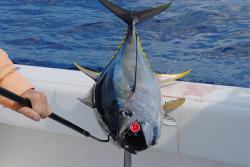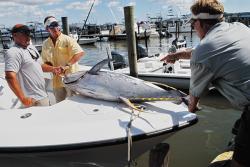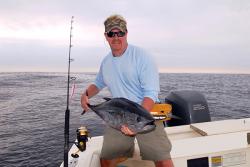Spinning for Tuna
from The Fishing Wire
Does spinning tackle have a place offshore?
This yellowfin slammed a popper fished on stout spinning tackle by the Yamaha team around oil rigs off Louisiana.
If you like offshore fishing imagine this—three days running around the Gulf of Mexico in a triple Yamaha-powered 42-foot Invincible center console doing nothing but fishing for yellowfin and blackfin tuna with surface plugs. The excitement of watching tuna attack a popper right before your eyes, not once, but again and again and again, is enough to give any saltwater angler heart palpitations. The Yamaha team recently spent some time with Bill Butler, owner of Venice Marina, aboard his tournament-rigged boat. Using his vast knowledge of the Gulf, Bill really put our team on the fish.
Casting poppers and working them in an erratic fashion to get a finicky gamefish to bite requires the right kind of tackle. This kind of tackle should be capable of making long casts and fast retrieves. Obviously, it’s a job for spinning tackle, but can spinning tackle stand up to the power of tuna? Not only was it able to, the gear we fished put quite a hurting on the fish, which ran from 25-pound blackfins to 70-pound yellowfins.
Even big tuna like this one can be handled with 65-pound-test braid on heavy spinning gear.Spinning tackle has come a long way on the big game scene in recent years. The introduction of ultra-expensive oversized spinning reels started with an elite fraternity of surf casters who needed big, strong reels with lots of line capacity and super-smooth drags – but it didn’t end there. After its introduction and rapid rise to popularity, vertical jigging became the next technique that got saltwater anglers interested in oversized spinning tackle. While casting is not a prerequisite when jigging, (most of which consists of positioning the boat over potential fish holding structure or schools of bait or gamefish and then dropping the jigs straight down) it does offer some strategic advantages. The key to successful vertical jigging is working the metals in a quick, erratic manner or with long lift and drop motions. Spinning tackle can pick up more line in a single turn of the handle than most high-speed conventional reels. Once this advantage was realized and it became obvious that the new generation reels could indeed hold up to the power of tuna, they started showing up on offshore grounds.
The revolution in heavy-duty spinning tackle didn’t stop with the surf crowd. All the major reel manufacturers stepped up to the plate with products that were bigger, stronger, held a ton of line and offered drags with enough stopping power to put the brakes on a small elephant. Today, manufacturers offer tuna-strong reels at more modest price points. When this phenomenon first began, only a few reels were available that could meet the rigorous demands of challenging pelagic brawlers, and they were very expensive, most in the $700 to $1,000 price range. Now there are models that can be purchased for under $300 and are capable of doing the job dependably.
Blackfins are another natural offshore target for spinning gear loaded with strong braid.Rod manufacturers also went back to the drawing board and developed a variety of specialty saltwater sticks that could cover the gamut of big game fishing needs, from jigging to casting surface lures. These products provide the actions and backbone necessary to make them applicable to catching tuna. They incorporate blends of materials that make them as close to indestructible as possible, and there are a variety of lengths and actions that cover the gamut of techniques used offshore.
In the Gulf with Butler, we used longer rods designed for casting and working poppers for tuna. Those rods were 7-feet 10-inches in length, and could throw surface plugs up to four ounces a long way. When fishing around oil and gas production platforms, casting distance is important and the longer rods did the trick. When a tuna was hooked, even the larger yellowfins, the rods proved to be excellent fighting tools.
When a tuna is hooked on the surface, the early phase of the fight can incorporate long runs near the surface, and the longer rods worked fine with the 65-pound test braided line and drag settings in the 18- to 20-pound range. As a tuna tires, it will run deep and eventually begin to circle straight below the boat. This requires a lot of lifting power to work it back to the surface, something longer rods with softer actions do not do well. But these tuna popping rods, while soft in the tip for casting, offered plenty of backbone to lift the fish during the end game.
Here’s some great eating, courtesy of spinning gear and a fast-moving plug.On a trip with Capt. Jim Freda of Shore Catch Charters in New Jersey (aboard his Yamaha-powered 28-foot Parker® Sport Cabin), team Yamaha had the opportunity to jig bluefin tuna. While some on board were fishing with conventional reels and jigging rods, Capt. Freda used a spinner with a jigging stick designed for tuna. He said he liked the way the spinning reel picked up line when he was dropping the flutter jigs to the bottom in a hundred-plus feet of water and then working them back up using a fast, erratic retrieve. He did a great job of making the jig dance, or at least the tuna thought so, because he hooked up frequently. He mentioned he has caught bluefin up to 100 pounds on spinning tackle, and has had clients beat fish considerably bigger on theirs.
Spinning tackle for offshore fishing has come of age, and it’s being used to catch fish that would have been considered unlikely at best just a few short years ago. It offers the offshore enthusiast another tackle option for challenging the ocean’s strongest pelagic species. Fishing for tuna with spinning tackle is both fun and productive. If you enjoy offshore fishing, give it a try this summer!



